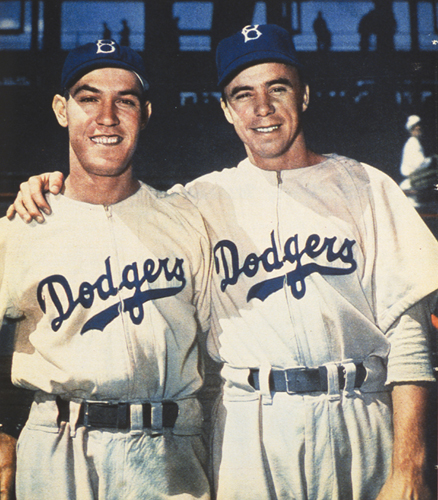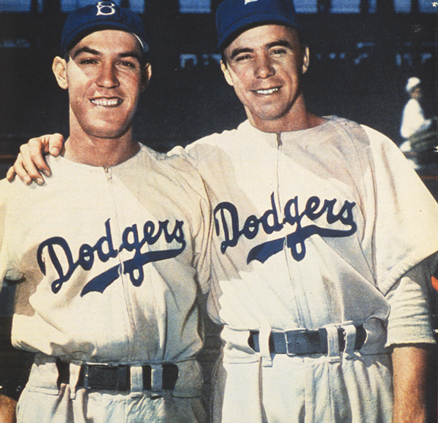September 11, 1946: Johnny Vander Meer’s tireless 15 innings end in futility

Pee Wee Reese and Pete Reiser made their major-league debuts at age 21 for the Dodgers in 1940, became All-Stars, then missed three full seasons (1943-1945) during World War II. While injuries derailed Reiser’s promising career, Reese became the emotional leader of the team and a Hall of Famer. (Photo: SABR-Rucker Archive)
Cincinnati’s Johnny Vander Meer had experience in momentous games at Ebbets Field prior to the Reds’ contest on September 11, 1946. Eight years earlier, he had etched his name in history with his second consecutive no-hitter.1 However, this time the southpaw’s magnificent outing wasn’t as much about limiting the number of hits by the opposing Brooklyn Dodgers as it was about his part in the longest game in major-league history to end in a scoreless tie. Vander Meer incredibly logged 15 out of the game’s 19 innings; but unlike the no-hitter, his effort went all for naught, since the game ended in a scoreless tie.
The 1946 season was turning into the latest chapter of an ongoing story about pennant competition between the Dodgers and St. Louis Cardinals. With the Dodgers trailing the Cardinals by two games, they were in a fierce battle for first place, so every game down the September stretch was important to each team. The race was reminiscent of the Dodgers’ run at the National League pennant against St. Louis in 1942 when they wound up finishing the season two games behind the Cardinals. When the Dodgers won their last pennant, in 1941, the Cardinals were the runners-up.
The Reds had been out of contention since the end of June, and the team continued to plummet in the standings, falling to 27½ games out of first place by September 11. They were a team of contrasting extremes, possessing the worst offense in the league while also featuring one of the best pitching staffs.
All major-league teams were recovering from the effects of World War II in 1946. The regular players, including most of the game’s stars, who had gone into military service returned to the sport.
Thirty-one-year-old Vander Meer missed the 1944 and 1945 seasons while serving in the US Navy. He understandably struggled to return to his pre-service form, when he had put together three seasons that resulted in 49 wins and a 2.71 ERA. His first five games of the 1946 season resulted in three losing decisions and a 5.47 ERA. After going 2-5, he seemed to get on track with six consecutive wins between June 28 and July 25, but then lost five of his next six decisions.
Manager Leo Durocher‘s Dodgers were led by outfielder Dixie Walker, who was among the league leaders in batting average and RBIs. Pete Reiser, Pee Wee Reese, and Cookie Lavagetto were among the servicemen returning to the Dodgers. On September 11, Hal Gregg drew the starting assignment against Vander Meer. He had been the ace of the Dodgers’ staff in 1945, claiming 18 wins. He was 5-3 coming into the September 11 game but his last six starts included two losses and four no-decisions.
The Reds wasted no time trying to get on the scoreboard. Dain Clay led off the game with a walk. He was thrown out by left fielder Reiser trying to go from first to third on Benny Zientara‘s single to left. Clay would take another aggressive baserunning chance in the 19th inning with the same result.
The next play exhibiting excitement occurred in the top of the fifth inning when the Reds’ Eddie Lukon was thrown out at the plate as he tried to stretch a triple into a home run. His smash off the right-center-field wall eluded outfielders Walker and Carl Furillo. Reiser chased down the ball and relayed it to Eddie Stanky, who threw to catcher Bruce Edwards for the tag on Lukon.2
Vander Meer was in control through the first 10 innings, allowing runners to reach second base only twice. He yielded five hits and a walk, and struck out 11. Gregg was equally effective in his 10 frames, giving up five hits and two walks and striking out six.
Gregg was relieved by Dodgers relief ace Hugh Casey to start the 11th inning. Casey was also stingy with Reds batters, giving up only two hits in his five innings.
Vander Meer breezed through five more innings, yielding only two more hits and walking one. Before he exited, he allowed a double to Lavagetto and intentionally walked Bruce Edwards in the 15th inning. Facing Joe Medwick, who was pinch-hitting for Casey, Vander Meer got out of the jam by inducing a groundout to end the inning.
Art Herring started the 16th inning for the Dodgers and ran into trouble when he gave up two singles, including one to Vander Meer. But then he retired the next two batters without a score.
Reds catcher Ray Mueller informed manager Bill McKechnie that his batterymate was tiring, and McKechnie wisely decided to lift Vander Meer for Harry Gumbert in the bottom of the 16th.3 Gumbert finished the game by holding the Dodgers to one hit.
With darkness approaching, Dodgers reliever Hank Behrman started the top of the 19th by walking Clay. A sacrifice bunt by Zientara moved Clay to second. Behrman intentionally walked Lonny Frey to face Bert Haas. When Clay attempted to score on Haas’s single, Dixie Walker made an accurate throw to Edwards, who blocked the plate and tagged out Clay. Clay protested the call, but umpire George Barr wasn’t entertaining his argument.4
The Dodgers momentarily thought they had salvaged the game when Reese led off the bottom of the 19th with a long fly ball to left-center, but the wind brought it back from the wall and it was caught by Max West.5 Gumbert retired Reiser and Walker to end the inning.
The game was called because of darkness after 4 hours and 40 minutes. The 19 scoreless innings approached a record set on August 1, 1918, between the Pittsburgh Pirates and Boston Braves that involved 20 innings without a score before the Pirates wound up winning the game in the 21st inning. The longest previous scoreless tie in the National League was a 16-inning contest on June 13, 1916, between Boston and Cincinnati.6
In another marathon game on September 11, the Chicago Cubs and Boston Braves played to a 3-3 tie after 17 innings.
Vander Meer’s performance extended his scoreless-innings streak against Brooklyn to 24. He tied a personal-best record of 14 strikeouts in a game, although his other two performances occurred in nine-inning games in 1941 and 1943.
About his decision to replace Vander Meer with Gumbert to start the 16th inning, McKechnie said, “Johnny wanted to continue, but I would never forgive myself if I would have permitted him to go on and something would have happened to his arm.” He added, “No one game is worth risking a pitcher’s future to win.”7
A victory would have moved the Dodgers to within one game of the Cardinals, who lost to Philadelphia that day, but they had to settle for a half-game improvement. The game was replayed on September 20. Vander Meer got the start again for the Reds, but this time he lasted only five innings and wound up with his ninth loss of the season.
The Dodgers eventually caught up with St. Louis, and the two teams wound up in a tie at the end of the regular season. The Cardinals defeated Brooklyn in a tiebreaker series to win their fourth pennant in five years. The Reds franchise wouldn’t be relevant again until 1956, when they won 91 games for a third-place finish.
Vander Meer finished the season with a 10-12 record, a 3.17 ERA, 11 complete games, and four shutouts. He pitched three more seasons for the second-division Reds, winning 17 games in 1948. He is most remembered for his consecutive no-hitters in 1938, but his 15-inning shutout performance ranks right behind them as a personal best.
SOURCES
In addition to the sources cited in the Notes, the author consulted Baseball-Reference.com and the following:
Holmes, Tommy. “Dodgers Open Crucial Card Series: Great Opportunity Lost by Failure to Defeat Reds,” Brooklyn Eagle, September 12, 1946: 12.
Lichtman, Paul. The Dutch Master: The Life and Times of Johnny Vander Meer” (New York: Vantage Press, 2001).
NOTES
1 Vander Meer pitched his consecutive no-hitters on June 11, 1938, in Cincinnati and June 15, 1938, at Ebbets Field.
2 Roscoe McGowen, “Dodgers Battle to 19-Inning Scoreless Tie With Reds; Cards Lose to Phils,” New York Times, September 12, 1946.
3 Lou Smith, “Reds and Brooks Scoreless in 19 Innings,” Cincinnati Enquirer, September 12, 1946: 1.
4 McGowen.
5 McGowen.
6 Harold Burr, “Six Help Tie Longest Zero Knot in Majors,” The Sporting News, September 18, 1946: 13.
7 Lou Smith. “Deacon Saves Vandy; Too Good to Abuse,” Cincinnati Enquirer, September 12, 1946: 16.
Additional Stats
Cincinnati Reds 0
Brooklyn Dodgers 0
19 innings
Ebbets Field
Brooklyn, NY
Box Score + PBP:
Corrections? Additions?
If you can help us improve this game story, contact us.


